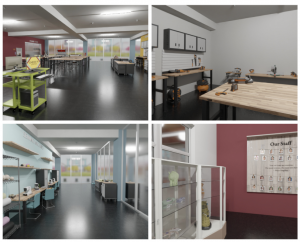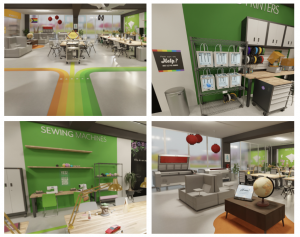From First Glance to Lasting Change
Introducing the Virtual Makerspace
Welcome to the Virtual Makerspace, a digital platform developed by the Equity in the Making (EiTM) Lab. This resource includes the original Virtual Makerspace, as well as the Redesigned Makerspace that implemented our findings from this study. This interactive resource is accessible on your computer or through a VR headset (i.e. HTC Vive or Oculus).

From top left to bottom right: threshold, power tools room, sewing area, display case and staff wall in the original Virtual Makerspace.

From top left to bottom right: threshold to the makerspace, 3D printing station, sewing station, laser cutter area
This resource is open access. The Virtual Makerspace is a generative tool to gain user reactions and feedback on a makerspace. We invite you to use it for learning, research, and community building purposes, for example. Here are five methods practitioners and researchers can implement using the Virtual Makerspace.
- Run a Tiny Cafe for Rapid Feedback
- Think-Aloud Reporting for a Participatory Observation
- Survey of Statements for Quantifying Experience
- Articulating Experiences with One Word Descriptions
- Power Analysis to Unveil Participant-Makerspace Dynamics
We believe that the Virtual Makerspace can be a helpful resource for educators and researchers who are looking to foster community-centered learning experiences based on direct user feedback. To learn more about the research that we used the Virtual Makerspace for, check out this presentation.
Background
Dr. Maggie Melo, who has spent nearly a decade working in a makerspace, became intrigued by the experiences of underrepresented students in university makerspaces. She observed a recurring pattern where students would approach the makerspace threshold, peer inside, and quickly retreat without entering. This phenomenon led Dr. Melo to wonder: “What causes students to shy away from makerspaces at the very threshold?” Her particular focus was on understanding the initial impressions and instinctive reactions that newcomers encounter when visiting a makerspace for the first time.
This work is being funded by the National Science Foundation (#1942930): “Equity in the Making: Investigating Spatial Arrangements of Makerspaces and Their Impact on Diverse User Populations.” The publication “Description framework of makerspaces: Examining the relationship between spatial arrangement and diverse user populations” outlines the research findings thus far.

